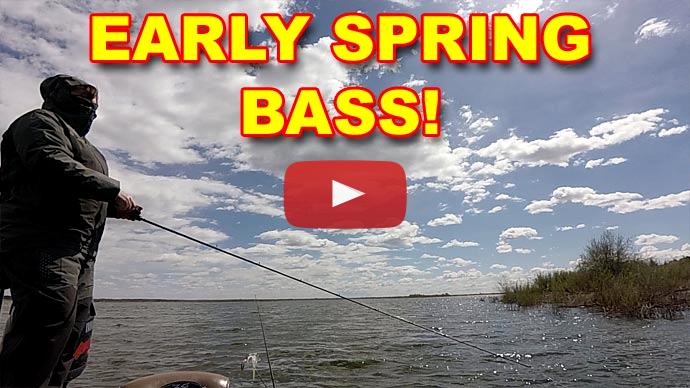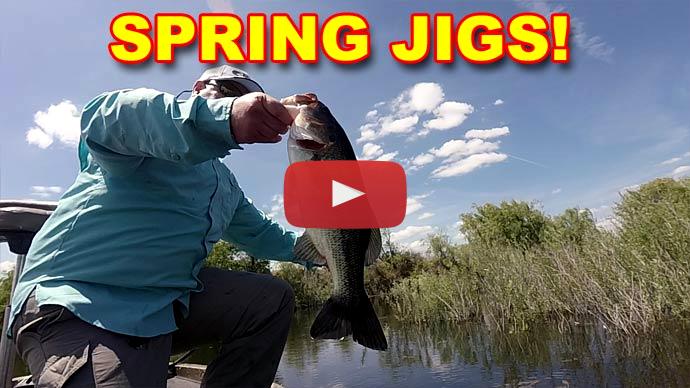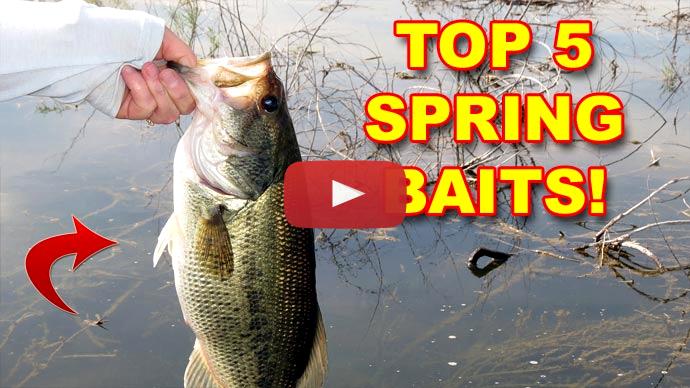Hey, folks, Glenn May here with BassResource.com. Today I want to talk about fishing those dreaded cold fronts during the spring, those post front conditions that can be really tough sometimes to catch fish. But if you follow the methodology and approach and the tips that I'm about to give you, you don't have to dread it anymore, you're actually going to go out and catch some fish.
So the first thing you need to understand is how these cold fronts affect bass and when they affect them. The key thing about a front coming through is, you know, you're getting ready to go have your trip this weekend or whatever it may be, the fishing has been good, you get these great fishing reports, and then here comes this front, it's going to happen right before you go out fishing or right when you go fishing.
When that front comes through, it tends to have a greater effect on the angler than it does on the bass because this front, I mean, come on, it's windy, it's cold, it's usually rainy out. It's uncomfortable. It's hard to fish in those conditions. But as that front's coming through, the bass, a lot of times, what they're doing prior to that front, if they've had a warming trend, is those fish will be up shallow, they'll be up actively feeding on baitfish, they're attacking lures, they're aggressive. And as this front's coming through and the weather conditions are really bad, a lot of times those fish haven't moved. They're still up shallow, they're still aggressive, they're still hitting fast-moving lures.
So don't assume that because the storm's coming through or front's coming through that the fish have now...they're not biting, they've hunkered down and they're done, they've moved off to deeper waters, and you can't catch them up shallow. Go out there and fish as if the front hasn't come through yet and let the fish tell you what their disposition is. A lot of times you'll be surprised to learn that they are still up shallow and they're still aggressively feeding even after the front has come through.
You know, they're not as affected, you know, 12 to 24 hours later because it takes a while for the water conditions to change when a front comes through. So a lot of times they'll still be up there actively feeding when you think that they're not. So don't get ahead of the fish. That's rule number one.
Now, after that front's come through, the winds start to die down, the skies start to clear up, the air temperature drops, the water temperature begins to drop, and the barometric pressure is going up and, yeah, you're in a post front condition, and that's when it starts to affect the fish. The greater the front, the stronger the front that's come through, the more it's going to affect them. But typically, you know, you see that water temperature drop three to five degrees, and yeah, you know, it's going to affect them but, again, probably not as much as you think. There's a lot of myths about that. A lot of people think that the bass will move, they've been up shallow, and now they're gonna move out to the, you know, deep parts of lake and they're gonna hunker down and they're not gonna bite at all. And that's not true.
The bass are gonna be one of two things. If they've been on the flats and actively feeding, if there's enough cover around, be it docks or thick weeds, flooded timber, bushes, they may just stay right there and just bury up into that cover and just hunker down and wait for the activity levels to pick back up again so they start feeding again. I mean, face it, if they've been up shallow and actively feeding, they've been successful, the food is there, they're not going to move far from the food. They're not going to move far from where they're successful. They're not going to abandon whole area and then come all the way back later to feed. They're just going to stay nearby, wait for those baitfish to start moving around some more and then, boom, they're gonna start feeding again. So they just may hang out in that area just buried up a little bit deeper that cover.
The other thing they may do is if they're up on a flat, they may just ease off a little bit deeper to nearby cover, say the flat is about 6 feet, 5 to 6 feet deep, they may move off to 8 to 10 feet deep. If there's chunk rock or there's logs on the bottom of the lake or deeper weed lines, they just may sit down in that area a little bit until conditions improve.
So they're not going to move very far. So the key thing, first of all, is if you can't find the fish right away, think about what is the nearest place that they can go to to hang out until conditions improve, they're not going to go far. So look at that 20 to 50-yard radius and start fishing those areas. You may just have to move just slightly deeper and you can reconnect with the fish.
Now like I said before, the stronger the front, the more it's going to affect them. So if that front comes through, it's been storming for a week, and the water temperature drops 5 to 10 degrees or more, then yeah, they're going to move deeper, they're going to move further, you know, to the main lake or into the creeks or, you know, wherever they can find deeper water so you may have to pull off and go even deeper and deeper if it's been a really strong storm that's come through. But you don't have to go all the way out there and start fishing at 45 feet of water. Don't start there. Start up shallow and work your way deeper until you connect with these fish with a very methodical approach and you'll find them.
Now for the baits that I like to use, there's really only four kinds that I use during this time of year or during this...when these conditions exist. One of them is, of course, the jig.
Jig fish right there. I like to use a rubber skirted jig during this time because what I do is I throw it out there on those weed lines, on that cover, and when it sits on the bottom, the rubber skirt just slowly opens all by itself. Okay. Put one in your tub or in your sink at home and you'll see it, it slowly opens up.
So you just throw it out there, let it sit in the bottom, and then do nothing. Just wait. I like to keep a little bit of a tight line on it because a lot of times the bass will come on, they look at and they go, and they just sit there and they don't move. So you won't really feel the bite, you might see your line twitch or move just a little bit, and that's all it takes. And yeah, set the hook when you see that. This is not a time to fall asleep and relax, which is hard to do when the bite's really slow like this, you can lose your concentration really quickly, but this is where you need to concentrate the most. If you don't get bit doing that way, just move the bait a little bit, scoot it just a couple of inches, and then tighten down on the line and let it sit again. With the boat, with the wave action, the boat moving, a little bit of waves hitting the line, with my arm moving just a little bit, even though I'm trying to keep it as steady as I can, and then that little skirt opening up like that, it just kind of quivers in place and just kind of moves and that's all it takes to get those bass to bite sometimes.
So one of the key changes I make to jigs during cold front conditions or post front conditions is that I'll remove that Rage Craw trailer on it that has a lot of action to it, it's got those flanges on the ends, that have a lot of movement when it falls. I'll remove that and put something that has less action on it, it's something like a V&M trailer on it that is smaller and doesn't have a ton of action on it. What it does is it's kind of mimicking the environment around them, what the baitfish and everything is doing, so it has less movement, it's more subtle and that entices a lot of the bites from reluctant bass during those times. Something that's got a lot of movement and action and flailing about looks unnatural to them and it's not...and it looks like something that can get away from them very quickly. So they're not...they're really reticent to bite that bait during a post current condition so that's why I use a trailer with a lot less action.
As for colors, what I like to do is basically I match the colors depending on the water clarity. If it's really muddy to dingy water or if it's cloudy and rainy outside, dark, you know, there's not a lot of light penetration in other words, I'll use darker color jigs, like a black and blue jig or black and purple, something like that. And then if it's clear water from, say, stained to really clear or if it's nice and sunny conditions like we have today, then I will use more natural colors. I'll stick to the greens and the brown hues like a green pumpkin with a matching trailer on it. Just you want something that looks something that the bass is used to seeing in those clear water conditions.
Now if they don't go for that, another bait that I'll use is a tube. I'll do a Texas rig tube jig and I'll fish it the exact same way like a three and a half-inch tube green pumpkin. Throw it out there, let it fall and again, I just drag it on the bottom. I'm not lifting and hopping and doing all these things, I'm not quivering the rod tip. The mood of the entire ecosystem right now is a lot slower. It's not that the fish aren't aggressive, it's just you're trying to match the activity level around them so it doesn't look unnatural. Okay, a lot of people think, "Oh, the bass are really afar jig, they're not going to chase baits." It's not that, it's the whole activity level of the environment. You come, this bait that's moving and making a bang and making all this noise when everything else is kind of calm and quiet and subdued, it really stands out as unnatural and that's not...bass are going to shy away from that. So you're trying to match that activity level is what you're doing. So think of it in that way. So a tube jig is another way to go after these fish, fish it the same way as the jig.
A third bait that I like to use is a suspending jerk bait, one that gets down to about 10 feet or so, and a true suspending jerk bait, not one that slowly floats up or slowly sinks but one that actually just sits there, because what I want to do is, say, for example, an outside weed line, as I'll crank it down to that outside weed line, and I want it to sit there and have a staring contest with the bass that are there and wait for one to blink. And I promise you, it's not going to be my jerk bait. But just let it sit there. And a lot of times the bass will come up and hit it when it's not even moving. And if I don't get bit then I'll just give a little crank of the reel handle just to give a little bit of movement, make it look a little alive, and then let sit again 30 seconds to a minute. Just don't even move it, and then give it a little twitch with your rod, just a little bit, just to get... What I think happens sometimes is either bass is looking at it and they're waiting for it to move, and that triggers a bite, or those bass are moving around those weeds, and they don't see it because it's not moving and it doesn't capture their attention, but a new bass will come along and suddenly this bait does a little bit of movement, they go," Whoa," and they come up and they go, "Whack," and they hit it. So you're not just having a staredown with one bass or two bass, you might be just attracting the bass in the area that hadn't noticed it before just by giving those little subtle movements. So think about it that way that you may be looking at a new audience every time you give that lure a little bit of a movement and then wait for them to react to it.
The last bait that I like to use during a cold front is a slow-rolled spinnerbait. It is a three-quarter ounce spinnerbait. It has a lot of bulk to it but not only that, but I can get it down deep and I can keep it down deep while I slowly crank it back. I'll throw it out there in that 8 to 10-foot zone, maybe we have some flooded timber, flooded bushes, but get it down there. The bass will a lot time sit down, hang down towards the bottom during a cold front period and post front, and I'll slowly roll it along there. Now those blades have a lot of lift to them, and sometimes it'll start bringing that bait up the water column, so you have to kill it and let it drop back down, and then resume your retrieve again. You just have to experiment with your particular spinnerbait to see how much lift it has and how much you need to do that. Some spinnerbaits, you can just slow roll along and it stays right along the bottom. So just experiment to find out how yours works.
But as I mentioned before, these fish aren't as lethargic as you think because a lot of times that approach, the bass will just crash that spinnerbait. I can't tell you how many times I've been in post front conditions, and the bass will come out just, bam, and hammer it hard, even though it's a hard post front condition. I don't know what it is that does that, I can't have an explanation for it, but a slow-rolled spinnerbait often elicits those vicious strikes even in a cold front condition, so it's a real good way to catch those fish during this period.
So that's how I approach fishing these cold front conditions during the spring. I hope those tips help. For more tips and tricks like this, visit BassResource.com.



